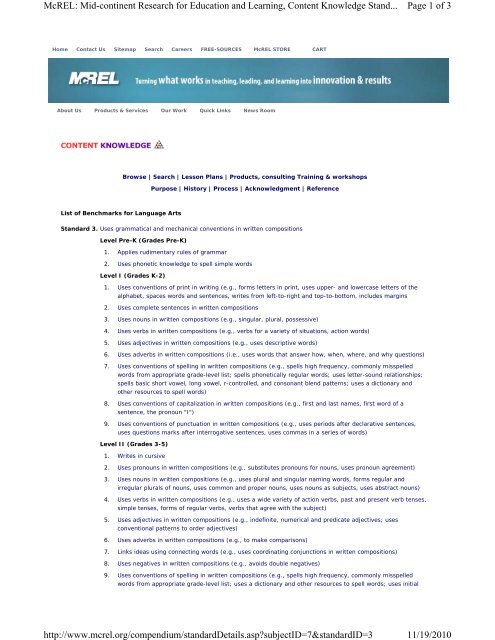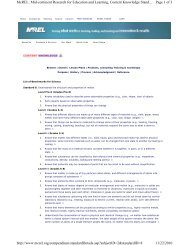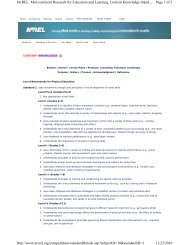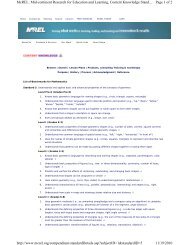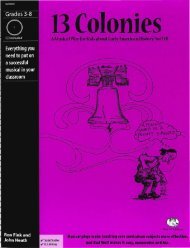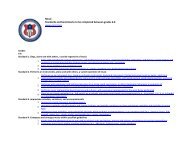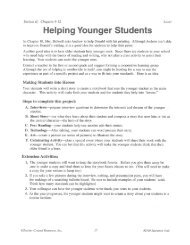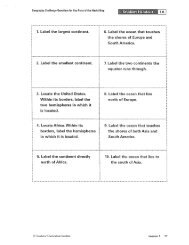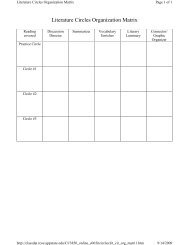McREL Standard 3 Writing
McREL Standard 3 Writing
McREL Standard 3 Writing
Create successful ePaper yourself
Turn your PDF publications into a flip-book with our unique Google optimized e-Paper software.
<strong>McREL</strong>: Mid-continent Research for Education and Learning, Content Knowledge Stand...<br />
http://www.mcrel.org/compendium/standardDetails.asp?subjectID=7&standardID=3<br />
Page 1 of 3<br />
11/19/2010<br />
Home Contact Us Sitemap Search Careers FREE-SOURCES <strong>McREL</strong> STORE CART<br />
About Us Products & Services Our Work Quick Links News Room<br />
Browse | Search | Lesson Plans | Products, consulting Training & workshops<br />
Purpose | History | Process | Acknowledgment | Reference<br />
List of Benchmarks for Language Arts<br />
<strong>Standard</strong> 3. Uses grammatical and mechanical conventions in written compositions<br />
Level Pre-K (Grades Pre-K)<br />
1. Applies rudimentary rules of grammar<br />
2. Uses phonetic knowledge to spell simple words<br />
Level I (Grades K-2)<br />
1. Uses conventions of print in writing (e.g., forms letters in print, uses upper- and lowercase letters of the<br />
alphabet, spaces words and sentences, writes from left-to-right and top-to-bottom, includes margins<br />
2. Uses complete sentences in written compositions<br />
3. Uses nouns in written compositions (e.g., singular, plural, possessive)<br />
4. Uses verbs in written compositions (e.g., verbs for a variety of situations, action words)<br />
5. Uses adjectives in written compositions (e.g., uses descriptive words)<br />
6. Uses adverbs in written compositions (i.e., uses words that answer how, when, where, and why questions)<br />
7. Uses conventions of spelling in written compositions (e.g., spells high frequency, commonly misspelled<br />
words from appropriate grade-level list; spells phonetically regular words; uses letter-sound relationships;<br />
spells basic short vowel, long vowel, r-controlled, and consonant blend patterns; uses a dictionary and<br />
other resources to spell words)<br />
8. Uses conventions of capitalization in written compositions (e.g., first and last names, first word of a<br />
sentence, the pronoun "I")<br />
9. Uses conventions of punctuation in written compositions (e.g., uses periods after declarative sentences,<br />
uses questions marks after interrogative sentences, uses commas in a series of words)<br />
Level II (Grades 3-5)<br />
1. Writes in cursive<br />
2. Uses pronouns in written compositions (e.g., substitutes pronouns for nouns, uses pronoun agreement)<br />
3. Uses nouns in written compositions (e.g., uses plural and singular naming words, forms regular and<br />
irregular plurals of nouns, uses common and proper nouns, uses nouns as subjects, uses abstract nouns)<br />
4. Uses verbs in written compositions (e.g., uses a wide variety of action verbs, past and present verb tenses,<br />
simple tenses, forms of regular verbs, verbs that agree with the subject)<br />
5. Uses adjectives in written compositions (e.g., indefinite, numerical and predicate adjectives; uses<br />
conventional patterns to order adjectives)<br />
6. Uses adverbs in written compositions (e.g., to make comparisons)<br />
7. Links ideas using connecting words (e.g., uses coordinating conjunctions in written compositions)<br />
8. Uses negatives in written compositions (e.g., avoids double negatives)<br />
9. Uses conventions of spelling in written compositions (e.g., spells high frequency, commonly misspelled<br />
words from appropriate grade-level list; uses a dictionary and other resources to spell words; uses initial
<strong>McREL</strong>: Mid-continent Research for Education and Learning, Content Knowledge Stand...<br />
http://www.mcrel.org/compendium/standardDetails.asp?subjectID=7&standardID=3<br />
Page 2 of 3<br />
11/19/2010<br />
consonant substitution to spell related words; uses vowel combinations for correct spelling; uses<br />
contractions, compounds, roots, suffixes, prefixes, and syllable constructions to spell words)<br />
10. Uses conventions of capitalization in written compositions (e.g., titles of people; proper nouns [names of<br />
towns, cities, counties, and states; days of the week; months of the year; names of streets; names of<br />
countries; holidays]; first word of direct quotations; heading, salutation, and closing of a letter)<br />
11. Uses conventions of punctuation in written compositions (e.g., uses periods after imperative sentences and<br />
in initials, abbreviations, and titles before names; uses commas in dates and addresses and after greetings<br />
and closings in a letter; uses apostrophes in contractions and possessive nouns; uses quotation marks<br />
around titles and with a comma for direct quotations; uses a colon between hour and minutes; use commas<br />
for tag questions, direct address, and to set off words)<br />
Level III (Grades 6-8)<br />
1. Uses pronouns in written compositions (e.g., uses relative, demonstrative, personal [i.e., possessive,<br />
subject, object] pronouns; uses pronouns that agree with their antecedent)<br />
2. Uses nouns in written compositions (e.g., forms possessives of nouns; forms irregular plural nouns)<br />
3. Uses verbs in written compositions (e.g., uses linking and auxiliary verbs, verb phrases, active and passive<br />
voice, appropriate mood [e.g., indicative, conditional, subjunctive], and correct forms of regular and<br />
irregular verbs)<br />
4. Uses adjectives in written compositions (e.g., pronominal, positive, comparative, superlative)<br />
5. Uses adverbs in written compositions (e.g., chooses between forms of adverbs such as positive,<br />
comparative, superlative degrees)<br />
6. Uses prepositions and coordinating conjunctions in written compositions (e.g., uses prepositional phrases,<br />
combines and embeds ideas using conjunctions)<br />
7. Uses interjections in written compositions<br />
8. Uses conventions of spelling in written compositions (e.g., spells high frequency, commonly misspelled<br />
words from appropriate grade-level list; uses a dictionary and other resources to spell words; uses common<br />
prefixes, suffixes, and root words as aids to spelling; applies rules for irregular structural changes) A<br />
9. Uses conventions of capitalization in written compositions (e.g., titles [books, stories, poems, magazines,<br />
newspapers, songs, works of art], proper nouns [team names, companies, schools and institutions,<br />
departments of government, religions, school subjects], proper adjectives, nationalities, brand names of<br />
products)<br />
10. Uses conventions of punctuation in written compositions (e.g., uses colons, quotation marks, and dashes;<br />
uses apostrophes in contractions and possessives, commas with introductory phrases and dependant<br />
clauses, semi-colons or a comma and conjunction in compound sentences, commas in a series, and ellipsis<br />
to indicate a pause, break, or omission)<br />
11. Uses appropriate format in written compositions (e.g., uses italics [for titles of books, magazines, plays,<br />
movies])<br />
Level IV (Grades 9-12)<br />
1. Uses pronouns in written compositions (e.g., reflexive, indefinite, interrogative, compound personal)<br />
2. Uses nouns in written compositions (e.g., collective nouns, compound nouns, noun clauses, noun phrases)<br />
3. Uses verbs in written compositions (e.g., present perfect, past perfect, and future perfect verb tenses;<br />
progressive verb forms, compound verbs)<br />
4. Uses adjectives in written compositions (e.g., adjective clauses, adjective phrases; relocates adjectives<br />
following nouns they modify)<br />
5. Uses adverbs in written compositions (e.g., adverb clauses, adverb phrases)<br />
6. Uses conjunctions in written compositions (e.g., correlative and subordinating conjunctions, conjunctive<br />
adverbs)<br />
7. Uses conventions of spelling in written compositions (e.g., spells high frequency, commonly misspelled<br />
words from appropriate grade-level list; uses a dictionary and other resources to spell words)<br />
8. Uses conventions of capitalization in written compositions ( e.g., within divided quotations; for historical<br />
periods and events, geological eras, religious terms, scientific terms)<br />
9. Uses conventions of punctuation in written compositions (e.g., uses commas with nonrestrictive clauses and<br />
contrasting expressions, uses quotation marks with ending punctuation, uses colons before extended<br />
quotations, uses hyphens for compound adjectives, uses semicolons between independent clauses, uses<br />
dashes to break continuity of thought)<br />
10. Uses commonly confused terms in written compositions (e.g., affect and effect)
<strong>McREL</strong>: Mid-continent Research for Education and Learning, Content Knowledge Stand...<br />
http://www.mcrel.org/compendium/standardDetails.asp?subjectID=7&standardID=3<br />
Page 3 of 3<br />
11/19/2010<br />
11. Uses standard format in written compositions (e.g., includes footnotes, uses italics [for works of art, for<br />
foreign words and phrases], uses bold or underlined headings)<br />
A = Assessment items available


